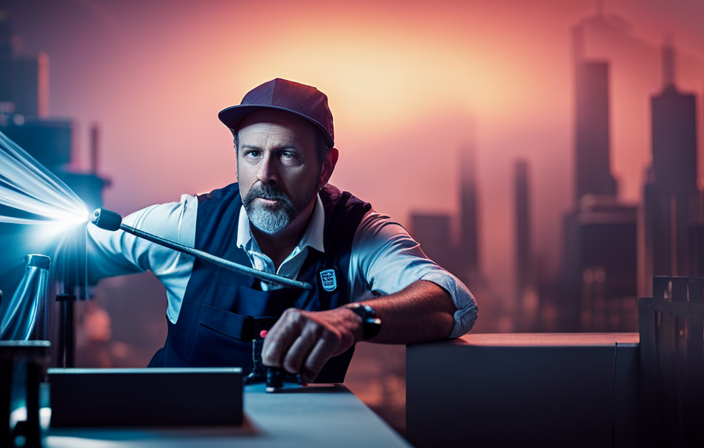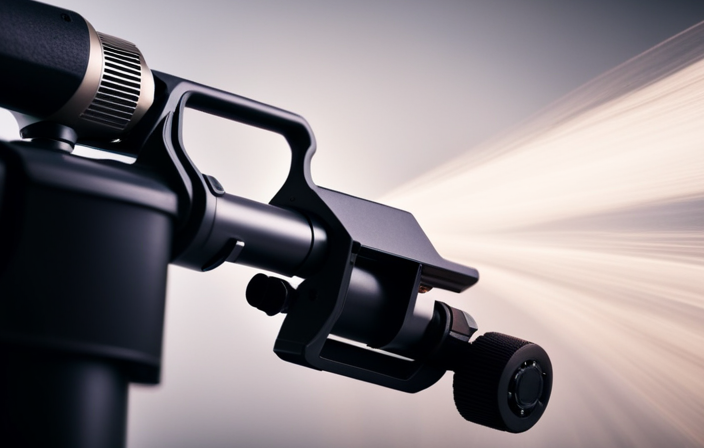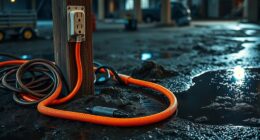Imagine this situation: you’ve completed a painting project using the reliable Graco TrueCoat 360DSP airless paint sprayer. Your walls are evenly covered, creating a visually pleasing result. You take a moment to admire the fruits of your labor. The important question that arises is: how should this essential tool be stored to maintain its durability and preserve it in excellent condition for future projects?
In this article, I will guide you through the precise steps of properly storing your Graco TrueCoat 360DSP airless paint sprayer.
First and foremost, it is crucial to clean the sprayer thoroughly after each use. This includes flushing out any remaining paint from the system, removing the spray tip and filter, and cleaning them with warm soapy water. Additionally, you should wipe down the exterior of the sprayer with a damp cloth to remove any paint residue.
Next, it is important to check for any damage on the seals and O-rings. These components are essential for the proper functioning of the sprayer, so any signs of wear or tear should be addressed immediately. If you notice any damage, it is recommended to replace the affected parts before storing the sprayer.
Once the sprayer is clean and all components are in good condition, it is time to store it properly. The ideal storage location is a cool, dry place where the sprayer will be protected from extreme temperatures and humidity. It is also advisable to store the sprayer in an upright position to prevent any potential leaks or damage.
In addition to these steps, it is a good idea to periodically inspect and maintain your sprayer even when it is not in use. This includes checking the fluid section for any clogs or debris, lubricating the pump shaft, and ensuring that all connections are tight and secure.
By following these detailed instructions, you can protect your investment and be confident that your Graco TrueCoat 360DSP airless paint sprayer will be ready to tackle any painting project that comes your way. So let’s dive in and learn how to store this invaluable tool with care.
Key Takeaways
- Extreme temperatures can negatively impact the functionality and quality of work of the Graco TrueCoat 360DSP airless paint sprayer.
- Chemical exposure can lead to corrosion of parts and compromise the efficiency of the sprayer.
- Regular inspection of seals and o-rings is crucial to prevent leaks and avoid expensive repairs.
- Using a protective cover or case can provide an additional layer of defense and extend the lifespan of the sprayer.
Clean the Sprayer Thoroughly After Each Use
Make sure to clean the sprayer completely after each use to keep your Graco TrueCoat 360DSP Airless Paint Sprayer in pristine condition and ready for your next painting project.
Proper storage techniques are essential for maintaining the longevity of your sprayer. Cleaning the sprayer thoroughly ensures that any leftover paint or debris is removed, preventing clogs and ensuring optimal performance.
Start by disconnecting the sprayer from the power source and emptying any remaining paint from the container.
Next, remove and clean the spray tip and guard. Use a cleaning solution recommended by the manufacturer and follow the instructions carefully. This step is crucial as it removes any dried paint or residue that could affect the sprayer’s performance.
By following these proper cleaning and storage techniques, you can prolong the life of your Graco TrueCoat 360DSP Airless Paint Sprayer and achieve professional-quality results.
Remove and Clean the Spray Tip and Guard
To properly maintain your equipment, start by taking off and thoroughly cleaning the spray tip and guard. This is an essential step in keeping your Graco TrueCoat 360DSP Airless Paint Sprayer in optimal condition. Here are three cleaning techniques and maintenance tips to ensure the best results:
-
Use a cleaning solution: Prepare a cleaning solution by mixing warm water with a mild detergent. Soak the spray tip and guard in the solution for a few minutes to loosen any dried paint.
-
Scrub gently: After soaking, use a soft-bristle brush to gently scrub away any remaining paint or debris from the spray tip and guard. Be careful not to use anything too abrasive, as it may damage the components.
-
Rinse thoroughly: Once scrubbed, rinse the spray tip and guard with clean water to remove any residue. Ensure all cleaning solution and paint particles are completely washed away.
By following these cleaning techniques and maintenance tips, you’ll be ready to move on to the next step of emptying and cleaning the paint container without any hassle.
Empty and Clean the Paint Container
After thoroughly cleaning the spray tip and guard, it’s time to empty and clean out the paint container. Cleaning techniques for the container are just as important as for the spray tip and guard. To ensure proper cleaning, follow these steps:
| Cleaning Techniques |
|---|
| Step 1: Remove the paint container from the sprayer. |
| Step 2: Pour any remaining paint into a sealable container for future use or dispose of it properly according to local regulations. |
| Step 3: Fill the container with a suitable cleaning solution, such as warm soapy water or a paint thinner recommended by the manufacturer. |
| Step 4: Attach the container back onto the sprayer and run the cleaning solution through the system, spraying it out through the spray tip. |
| Step 5: Repeat this process until the container and system are thoroughly cleaned. |
Proper disposal methods for the cleaning solution and any leftover paint should be followed according to local regulations. After emptying and cleaning the paint container, it’s essential to store the sprayer in a clean and dry area.
Store the Sprayer in a Clean and Dry Area
Find a safe spot to keep your sprayer, making sure it’s clean and dry. Proper maintenance and the importance of storing the Graco TrueCoat 360DSP airless paint sprayer correctly cannot be stressed enough. After cleaning the paint container, it is crucial to store the sprayer in a clean and dry area.
This will help prevent any moisture or dust from accumulating and potentially damaging the sprayer. Ensure that the storage area is free from any potential hazards, such as sharp objects or extreme temperatures. Additionally, it’s advisable to protect the sprayer from dust and debris by covering it with a clean cloth or plastic bag.
This will further safeguard it from any potential damage.
Protect the Sprayer from Dust and Debris
To protect the sprayer from dust and debris, it is important to take certain precautions. One way to do this is by keeping the sprayer covered with a clean cloth or plastic bag. This will shield it from any particles that may be in the air, especially if you are storing the sprayer in an area with a lot of sawdust or other debris. Dust and debris can easily clog the spray nozzle and affect the overall performance of the sprayer.
In addition to covering the sprayer, it is also worth considering the use of a spray booth for your painting projects. A spray booth provides a controlled environment that helps prevent dust and debris from settling on your painted surfaces. This can greatly improve the quality of your finished work.
When it comes to storing paint cans, it is important to properly seal them to prevent any spills or leaks. This not only helps keep your storage area clean but also prevents any accidents from occurring.
Now, let’s move on to the next section, which will discuss the proper way to store the sprayer in an upright position.
Store the Sprayer in an Upright Position
To ensure the longevity and optimal performance of your Graco TrueCoat 360DSP Airless Paint Sprayer, it is vital to store it properly. In addition to protecting the sprayer from dust and debris, storing it in an upright position is crucial. This position helps prevent any potential damage to the delicate components and ensures that the sprayer remains securely in place.
To further emphasize the importance of proper storage, let’s compare it to other types of paint sprayers. While the storage techniques may vary slightly, the underlying principle remains the same – maintaining a consistent spray pattern. This is vital not only for airless paint sprayers like the TrueCoat 360DSP but also for other types of sprayers.
To help you visualize the importance of maintaining a consistent spray pattern, take a look at the table below:
| Sprayer Type | Spray Pattern Consistency |
|---|---|
| Airless | Highly consistent |
| HVLP | Moderate consistency |
| Compressed Air | Less consistent |
By storing your TrueCoat 360DSP in an upright position, you are not only protecting it from dust and debris but also ensuring a consistent spray pattern. This is essential for achieving professional-quality results. Now, let’s move on to the next section and discuss how to keep the sprayer away from extreme temperatures.
Keep the Sprayer Away from Extreme Temperatures
To safeguard the performance and protect your investment of the Graco Truecoat 360DSP Airless Paint Sprayer, it is important to avoid exposing it to extreme temperatures. Extreme heat or cold can have negative effects on the functionality of the sprayer.
High temperatures can cause the paint to dry up quickly, leading to clogging issues and affecting the quality of your work. On the other hand, extremely cold temperatures can cause the paint to thicken, making it difficult for the sprayer to pump effectively.
In addition to temperature considerations, it is also important to keep the sprayer away from any chemicals that could potentially damage its components. Chemicals can corrode the sprayer’s parts, leading to leaks and decreased performance.
After ensuring that the sprayer is kept in a suitable temperature-controlled environment and away from harmful chemicals, it is important to regularly check the seals and o-rings for any signs of damage or wear. This will be discussed in more detail in the subsequent section.
Check the Seals and O-Rings for Damage
Ensure that you regularly inspect the seals and o-rings for any signs of damage or wear, as neglecting this simple task could lead to costly repairs and compromised performance. Properly inspecting the seals and o-rings is crucial to prevent leaks and maintain the efficiency of your Graco Truecoat 360DSP airless paint sprayer. Here are a few tips to help you with the inspection:
- Check for cracks or tears in the seals and o-rings.
- Look for any signs of wear or distortion.
- Ensure that the seals and o-rings are properly lubricated.
By regularly inspecting and maintaining the seals and o-rings, you can prevent leaks and ensure that your paint sprayer functions optimally.
Once you have completed the inspection, it is time to move on to the next step: using a protective cover or case for extra protection.
Use a Protective Cover or Case for Extra Protection
Using a protective cover or case adds an extra layer of defense to your Graco Truecoat 360DSP. It safeguards the sprayer from potential damage, protecting against dust, debris, accidental bumps, and falls. The benefits of using a protective cover are numerous. It keeps the sprayer in pristine condition, prolonging its lifespan and ensuring optimal performance. Additionally, it prevents any paint residue from leaking out, which could be messy and time-consuming to clean up.
While there are alternative storage options available, such as wrapping the sprayer in a soft cloth or placing it in a dedicated storage box, a protective cover offers the most comprehensive protection. By utilizing a protective cover, you can rest assured that your Graco Truecoat 360DSP will remain safe and secure.
Transitioning into the next section, regularly maintaining and servicing the sprayer is crucial for its longevity.
Regularly Maintain and Service the Sprayer to Ensure Longevity
Taking proper care of your Graco Truecoat 360DSP is essential for its longevity. One way to achieve this is by regularly maintaining and servicing the sprayer.
By regularly maintaining and servicing the sprayer, you can ensure that it continues to function optimally and avoids common issues that may arise.
One of the ways to maintain the sprayer is by troubleshooting any problems that may occur. For example, if you notice a decrease in performance, you can check for clogs in the nozzle or clean the filters to improve the spray pattern.
Additionally, it is beneficial to use a professional maintenance service for the sprayer. They have the expertise and tools to thoroughly clean and inspect the sprayer, ensuring that all components are in good working condition.
This can prevent potential issues and extend the lifespan of your Graco Truecoat 360DSP.
Frequently Asked Questions
How often should I clean the graco truecoat 360dsp airless paint sprayer after each use?
To keep your Graco TrueCoat 360DSP airless paint sprayer in top shape, it’s essential to clean it thoroughly after each use. Here are some tips for proper cleaning and maintenance to ensure its longevity and performance.
Is it necessary to remove and clean the spray tip and guard regularly?
Regularly removing and cleaning the spray tip and guard of an airless paint sprayer is crucial for maintaining optimal spray performance. It prevents clogs and ensures a smooth and consistent spray pattern, saving time and ensuring a professional finish.
What should I do if I accidentally leave paint in the container for an extended period of time?
If you accidentally leave paint in the container for too long, it can cause clogs in your paint sprayer. To properly clean it, you’ll need to disassemble the sprayer and use a cleaning solution to remove any leftover paint.
Can I store the sprayer in a damp or humid area?
To prevent rust on your paint sprayer and ensure its longevity, it’s crucial to store it in a dry area. Humidity can cause corrosion and damage the sprayer’s components, so keeping it in a moisture-free environment is essential.
How frequently should I check the seals and o-rings for damage?
To properly maintain the seals and o-rings of a Graco TrueCoat 360DSP airless paint sprayer, it is important to check them for damage regularly. Signs of damage include leaks, cracks, or wear.
Conclusion
In conclusion, properly storing your Graco TrueCoat 360DSP airless paint sprayer is crucial for its longevity and performance. By following the steps outlined in this article, you can ensure that your sprayer remains in excellent condition.
Firstly, it is important to clean the sprayer thoroughly after each use. This includes flushing out any remaining paint, cleaning the nozzle, and removing any clogs or blockages. This will prevent any residue from drying and clogging the sprayer, which can lead to performance issues.
Once the sprayer is clean, it should be stored in a clean and dry area. This will protect it from dust, debris, and moisture, which can cause damage over time. It is also recommended to store the sprayer in its original case or a dedicated storage case to provide additional protection.
Regular maintenance and servicing are also essential for the longevity of your sprayer. This includes checking and replacing any worn or damaged parts, lubricating moving components, and ensuring that all connections are tight and secure. Following the manufacturer’s instructions for maintenance intervals and procedures is highly recommended.
By treating your sprayer like a precious gem and protecting it from dust and debris, as well as regularly maintaining and servicing it, you can ensure that it remains in excellent condition. With proper care, your sprayer will continue to deliver flawless paint jobs every time.










